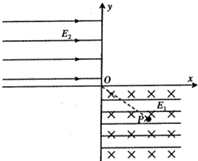在如图所示竖直平面坐标系内,在第四象限内存在垂直纸面向里的匀强磁场和水平方向 的匀强电场,磁感应强度为B,电场强度E1的大小和方向未知.质量为m、带电量为q的 液滴从p点沿图中虚线匀速运动到原点o进入第二象限,在第二象限内存在水平向右的 匀强电场,其场强大小为E2.已知P点坐标为(4L,-3L),重力加速度为g.求:
(1)E1的方向和大小.
(2)液滴在第四象限匀速运动的速度大小.
(3)液滴通过0点后再次通过x轴时的坐标.

(1)带电粒子由P运动到O的过程中,粒子受到重力、电场力、洛伦兹力三个力作用,如图所示.故 粒子带负电,电场方向水平向右.
解得:E1=
.3mg 4q
(2)
=mg qvB
,解得v=4L 5L
.5mg 4qB
(3)液滴进入第二象限后,将速度沿坐标轴分解

vx=
v=4 5
vy=mg qB
v=3 5 3mg 4qB
液滴沿x轴负方向做匀加速直线运动,沿竖直方向上做竖直上抛运动
t=
=2vy g
.3m 2qB
水平方向上位移大小x=vxt+1 2
t2=qE2 m
+3m2g 2q2B2 9mE2 8qB2
坐标为(-
-3m2g 2q2B2
,0).9mE2 8qB2
答:(1)E1的方向水平向右,大小为E1=
.3mg 4q
(2)液滴在第四象限匀速运动的速度大小为
.5mg 4qB
(3)液滴通过0点后再次通过x轴时的坐标为(-
-3m2g 2q2B2
,0).9mE2 8qB2
